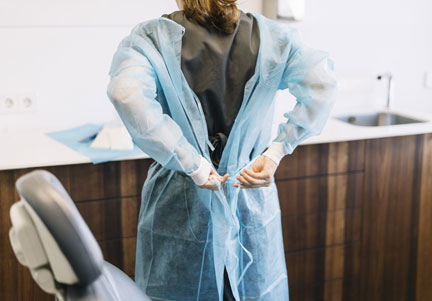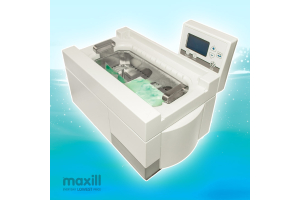Gowns, Gowns and more Gowns: A Guide To Choosing The Right Protective Gown

Choosing the Right PPE
The routine practice of PPE selection is based on a proper risk assessment.
This involves choosing the appropriate uniforms, shoes, gloves, surgical masks, respirator masks, eye protection, face shields, gowns, hair caps and shoe covers.
Depending on the practice setting, this entire lineup maybe your ‘norm’ or it may be a new PPE shopping experience if you were not using the complete PPE spectrum in the past.
As the lineup of PPE expands, decisions need to be made on specific products and their performance.
This is simple when the products are regulated, and with any luck, that regulation includes registration with Health Canada (or FDA for the USA) or at least inclusion in a medical class device listing.
Isolation VS Surgical Gowns
Gowns have several alias names: surgical gowns, isolation gowns, surgical isolation gowns, non-surgical gowns, procedural gowns, operating room gowns, single-use gowns, reusable gowns, etc.
The Government of Canada defines the two gown types as the following:
- Isolation gowns protect the clothing of health care providers. They also protect visitors and patients because they prevent the transfer of microorganisms and body fluids in patient isolation situations (1).
- Surgical gowns are sterile textile gowns. Health care providers wear these gowns when they are working in a sterile environment (1).
“All medical gowns are classified as Class I medical devices. Class I devices present the lowest potential risk and are subject to the Medical Devices Regulations. Despite their classification as low risk, medical gowns serve an important function. Pathogens are unable to penetrate the material, which protects both the wearer and the patient.” (1)
How to Choose The Right Gown To Use In Different Clinical Settings
Surgical Gowns
How do you pick between an isolation gown and a surgical gown?
Dental treatment is not offered in a sterile setting, therefore automatically eliminating sterile gowns.
Now that being said, should an office wish to use sterile gowns, have at it.
No one is putting the brakes on their use, however, be prepared to have a method for the sterilization of textiles.
The office could potentially choose sterile gowns for the more invasive procedures, noting this is not a MUST in the standards.
Isolation Gowns
Isolation gowns are the more typical choice for a dental office and they serve the purpose of a barrier to protect the health care professional (HCP) from splatter, spraying, droplets, droplet nuclei - the entire aerosol lineup.
The level of risk is highly tied to the type of services being offered.
If the service is not generating aerosols (NAGP) a lower risk gown can be selected as there will not be any spray, splatter and aerosols.
If the procedure involves aerosols (AGP) then a higher protection gown can be chosen as there is a potential for spray, splatter and aerosols.
Nonsterile, disposable isolation gowns, which are used for routine patient care in healthcare settings, are appropriate for use (2).
The Most Important Thing to Consider When Choosing a Gown
What is the most important performance factor for a gown?
Fluid resistance.
Testing centres test gowns with various methods of fluid penetration: impact, hydrostatic, synthetic blood and viral.
The following table from the CDC depicts the performance of gowns based on the ASTM and AATCC testing for potential fluid penetration.
The more fluid resistance a gown demonstrates the more ideal its selection is for AGP.
The following table from the CDC displays how each level is challenged, the result of the challenge and the expected barrier effectiveness.
Note that the levels of 1-4 start with lower effectiveness to the fluid barrier and climb to a higher level of protection.
Table 1:
| Level1 | Test | Liquid Challenge | Result | Expected Barrier Effectiveness |
|---|---|---|---|---|
| 1 | AATCC 42 Impact Penetration2 | Water | ≤ 4.5 g | Minimal water resistance (some resistance to water spray) |
| 2 | AATCC 42 Impact Penetration | Water | ≤ 1.0 g | Low water resistance (resistant to water spray and some resistance to water penetration under constant contact with increasing pressure) |
| AATCC 127 Hydrostatic Pressure3 | Water | ≤ 20 cm | ||
| 3 | AATCC 42 Impact Penetration | Water | ≤ 1.0 g | Moderate water resistance (resistant to water spray and some resistance to water penetration under constant contact with increasing pressure) |
| AATCC 127 Hydrostatic Pressure | Water | ≤ 50 cm | ||
| 4 | ASTM F1670 Synthetic Blood Penetration Test (for surgical drapes) | Surrogate Blood | no penetration at 2 psi(13.8 kPa) | Blood and viral penetration resistance (2 psi) |
| ASTM F1671 Viral Penetration Test (for surgical and isolation gowns) | Bacteriophage Phi-X174 | no penetration at 2 psi(13.8 kPa) | ||
| 1 In order of increasing protection2 American Association of Textile Chemists and Colorists (AATCC) 42 Water resistance: impact penetration test determines the ability of a material to resist water penetration under spray impact [AATCC 2000] 3 AATCC 127 Water resistance: hydrostatic pressure test determines the ability of a material to resist water penetration under constant contact with increasing pressure [AATCC 1998] | ||||
Tabel 1 adapted from this.
Let’s compare the CDC table to the Government of Canada.
The Government of Canada table has a simplified presentation and classifies the levels of the gowns as two main categories of Low and High risk into their intended usage and, like the CDC, uses the range of 1-4 for the levels.
Table 2:
| Level of Gown | Application for Use |
|---|---|
| Low Risk | |
| 1 | minimal risk; used for standard precautions and simple procedures |
| 2 | low risk; used for minimally invasive surgery |
| High Risk | |
| 3 | moderate risk; used for open gastrointestinal surgeries |
| 4 | high risk; used for open cardiovascular and trauma procedures |
Adapted from: Health Canada
Both tables are consistent in the levels of risk.
From this information, it can be concluded that a dental office can safely utilize a level 1 or 2 gowns and of course can still use a level 3 or 4 should they see the need.
The deciding factor in dentistry, as stated earlier, is whether the services are AGP or NAGP.
To help you navigate the maxill product line of gowns see Table 3 for a table listing specific gown types, if they are reusable or disposable, their level # and the application into practice for either an AGP or NAGP (obvious that every gown can be used for NAGP but would be ‘overkill’ if choosing a higher level).
maxill has a variety of gowns that are listed in the table below along with their performance.
Table 3:
| Item | Disposable or Reusable | Level | Application to Practice |
|---|---|---|---|
| maxill CPE Isolation Gowns | Disposable | 1 | NAGP |
| maxill aquist Isolation Gowns | Disposable | 2 | AGP |
| maxill aquist Washable Isolation Gowns | Reusable | 2 | AGP |
| Packard Healthcare Isolation Gowns | Disposable | 2 | AGP |
*Note: All gowns can be used for NAGP.
Selecting The Right Gown for Reprocessing
What about the gown selection for the reprocessing task?
If an office's reprocessing routine includes manual cleaning with a brush and/or the use of an ultrasonic bath for instrument cleaning then automatically a gown is needed that can endure a potential splashing when moving the instruments in and out of the basket as well as rinsing them.
A level 1 gown would not be the selection, but the level 2-4 would as this is an AGP (level 2 being very acceptable).
Let’s compare that to an office that has no ultrasonic bath and uses an instrument washer and no manual scrubbing.
What gown is then required?
Here the selection is all levels and can include a level 1 gown as this is a NAGP.
Things to Consider When Selecting Reusable Gowns
Reusable gowns are growing in popularity and are a great environmentally-conscious option, yet they come with a few catches.
The number of times they are washed must be tallied as they have an expiration on the number of uses.
Each gown is traced and logged.
For example, the maxill reusable gown has a limit of 75 washes and presents with a tally board inside the left corner of the panel that can be checked off with a fabric marker at each laundering.
Utilizing the gown post its expiration date would conclude in the gown not living up to its intended performance.
Laundering of reusable gowns can unfold on-site in a dental office or via a laundering service.
It is not recommended to take gowns home for laundering.
The following should be considered for a system of reusable gowns:
Considerations for Reusable Gowns:
- Cost of the gowns
- The durability of the textile/fabric
- Staff expenses to collect, sort, launder, fold and store
- Energy costs for laundering on site
- The laundry room must be separate from operatories, reprocessing area and lunchroom
- The laundry room must have adequate air quality *dryer vented to the outside*
- Clean gowns must be stored, dispensed and retrieved in a method they are not contaminated
- The laundry machine and dryer must follow a proper cleaning and disinfection routine
- PPE is required to handle both the soiled and clean gowns
- The presence of distinct separation from the dirty ‘side’ to the ‘clean’ side in the laundry room
- The collection receptacles, if solid material, need to be disinfected and if fabric bags, the bags need to be laundered at every collection
- Decisions need to be made for the location of the laundry collection receptacles
Note: It is wise to consult with any dental regulatory body and/or public health for the directives regarding the laundering of reusable gowns for your specific geographical area.
To Sum It Up
Dentistry was in the same boat years ago with the decision-making process of picking the mask for the task.
This is a catchy phrase that alerts us that there will be a decision to be made for the mask selection ‘before’ donning the mask.
We are being asked the same for gowns based on a proper risk assessment.
Gowns are by far not new to the lineup of dental PPE and have been part of the educational IPAC curriculum in dental schools for several years.
Any dental grad from the last 10 years will remember strict protocols of when and when not to don a gown as well as proper doffing steps.
Knowing more information about gowns hopefully solves some dilemmas for selection and usage.
The dental PPE lineup is full.
With all these PPE layers be sure to lower the thermostat setting.
Remember to ‘pick the mask for the task’ and ‘go to town with the right gown!'
For gowns, other PPE, or any kind of infection control or procedural product, maxill has you 'covered'.
And on top of that, out of all the dental suppliers on the market, maxill has the clearest and lowest pricing.
Instead of looking up "dental suppliers near me" in a search engine, just check out our website!
You'll find an amazing line of essential medical and dentistry supplies, just waiting for you to scoop up!
Resources
1. Government of Canada. Personal protective equipment against COVID-19. Medical gowns. 2020. https://www.canada.ca/en/health-canada/services/drugs-health-products/medical-devices/covid19-personal-protective-equipment/gowns.html?wbdisable=true
2. Centre for Disease Control. Personal Protective Equipment: Questions and Answers. March 14, 2020. https://www.cdc.gov/coronavirus/2019-ncov/hcp/respirator-use-faq.html
3. Centre for Disease Control. Strategies for Optimizing the Supply of Isolation Gowns. 2020. https://www.cdc.gov/coronavirus/2019-ncov/hcp/ppe-strategy/isolation-gowns.html





